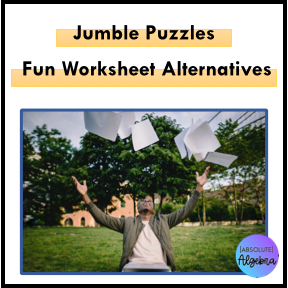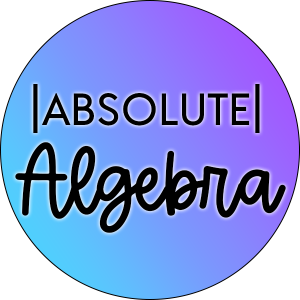I wanted to do something fun for Halloween with my Algebra students. So I grabbed my bag of candy and headed for school. I was thinking of a LOW PREP math review game. I used to teach middle school and remembered a reward type system where I drew a grid on a piece of paper and when students completed their homework they put their initials in the boxes of the grid. Every few weeks I would randomly pull numbers and they would get rewards.
So I am standing in my classroom before school thinking how I could turn this reward system into a game. I had large grid paper, I had dry erase boards, so I went for it! I am calling it the “Grid Game”. My Algebra students really enjoyed it, and you can use it with any grade or subject.
Object of the Game:
To get your initials in as many boxes of the grid so you have the best chance of your name being called.
Materials:
- Problems/questions for your students
- Dry erase boards (one per student)
- Dry erase markers (one per student)
- Large grid paper or butcher paper
- Regular markers
- Small squares of paper (about 50-100)
- Bag or bowl for the small squares of paper
- Small candies or rewards for students
Creating the Game:
Create a large grid like this:
Next create small squares of paper that correspond to the horizontal and vertical axes of the grid, like this:
Note: There will be many winners in this game and some students will win multiple times. Each time a student gets a problem correct, the student puts their name or initials in a box on the grid.
How to Play:
Give students a dry erase board and a marker. Tell them that will have one chance to answer the question on the dry erase board. However, if the problem is long or they need to show work, give them more than one chance.
When the grid is full you pull a square from the bowl. Then look at whose initials are in the box and that student comes up to claim their prize.
Student Rules:
The answer must be clearly written and circled. I will either say yes or no if you get the problem right or not.
Do not stand up to put your name in the grid until I tell you, otherwise I won’t be able to see other students’ answers.
Do not show your answer to other students because that will be fewer chances for you to get your name on the grid. After I say “yes” or “no” turn your dry erase boards over so other students cannot see their answer.
Teacher Process:
Before I give the students a question, I review the same type of question so that the students who don’t retain information well can have a fair chance to get the problem correct.
Check for understanding:
I have small classes, so I take notes to see who is understanding the material when they show me their dry erase board. This way I can reteach during another time with those students. You can create a chart with the students’ names and skills that you will be reviewing so you can check off who is getting which problems correct and who still may need help.
Give them time to think:
Some students need more time than others to answer the questions. Give your class time to process the material. You may want to have all the students put their boards up at the same time after a designated amount of time and then say yes or no at that time.
Follow up after the problem:
Explain the answer to the students so they know why they got their problem incorrect.
Types of Problems:
Try to create your problems so that you can get multiple questions from it. For example, in Algebra I would project the equation on the board like y=7x-5. I could create many questions with this one equation like:
- What is the slope?
- What is the y-intercept?
- What is the zero?
- How do you write this equation in standard form?
- Graph the equation.
- Solve for x.
- Does this equation have a positive or negative slope?
- How does this graph transform from the parent function?
(You get the idea!)
Another idea:
Use Nearpod, Padlet, or another type of interactive computer site instead of dry erase boards. This way the students will have to wait for all the students instead of writing their answer on the board and immediately holding it up while jumping up and down waiting for you to tell them if it is correct or not.
Types of Prizes:
- Small Candies
- Small Toys
- Extra Points
- Free time
Here are some Algebra resources to use for “The Grid Game”:
Mini Task Cards about Quadratics
Mini Task Cards about Linear Functions
Here are some middle school resources to use:
Converting Fractions to Decimals to Percents
Multiplying and Dividing Fraction Word Problems
or Check out my store for all the resources!
Click here to sign up to get the rules in a convenient PDF version.
What kinds of review games do you play with your students? Let me know in the comments below.




